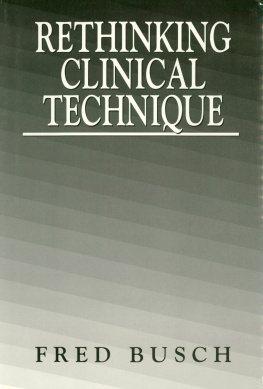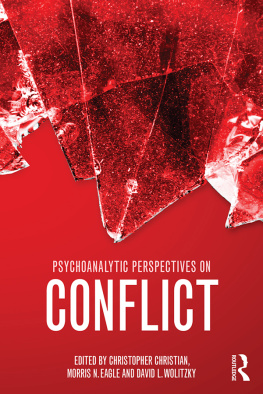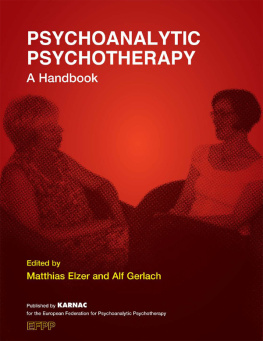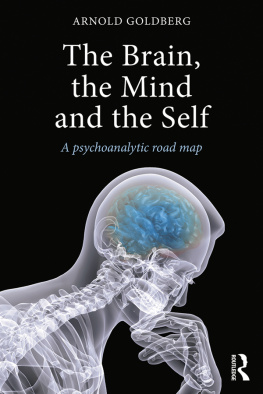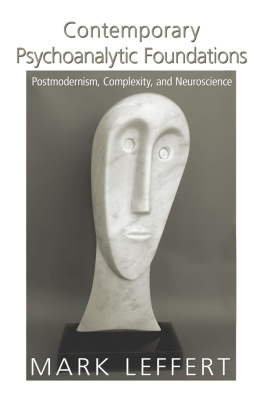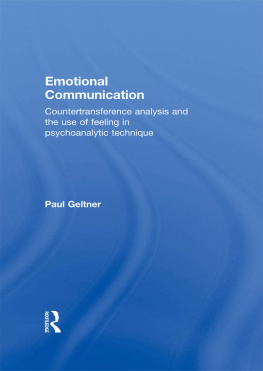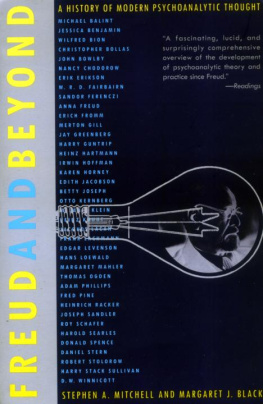
CREATING A PSYCHOANALYTIC MIND
A psychoanalytic method and theory
Fred Busch

First published 2014
by Routledge
27 Church Road, Hove, East Sussex BN3 2FA
and by Routledge
711 Third Avenue, New York, NY 10017
Routledge is an imprint of the Taylor & Francis Group, an informa business
2014 Fred Busch
The right of Fred Busch to be identified as author of this work has been asserted by him in accordance with sections 77 and 78 of the Copyright, Designs and Patents Act 1988.
All rights reserved. No part of this book may be reprinted or reproduced or utilized in any form or by any electronic, mechanical, or other means, now known or hereafter invented, including photocopying and recording, or in any information storage or retrieval system, without permission in writing from the publishers.
Trademark notice: Product or corporate names may be trademarks or registered trademarks, and are used only for identification and explanation without intent to infringe.
British Library Cataloguing in Publication Data
A catalogue record for this book is available from the British Library
Library of Congress Cataloging in Publication Data
Busch, Fred, 1939
Creating a psychoanalytic mind : a psychoanalytic method and theory / Fred Busch.
pages cm
Includes bibliographical references.
ISBN 978-0-415-62904-1 (hbk.) ISBN 978-0-415-62905-8 (pbk.)
ISBN 978-1-315-88852-1 (ebk.) 1. Psychoanalysis. I. Title.
RC504.B87 2014
616.8917dc23
2013010752
ISBN: 978-0-415-62904-1 (hbk)
ISBN: 978-0-415-62905-8 (pbk)
ISBN: 978-1-315-88852-1 (ebk)
In a 1963 interview with B. Swerdloff, Heinz Hartmann mused on his Vienna analytic days. He commented how he and Ernst Kris were greatly impressed with Freud, but never thought that it was the end of psychology. We always felt that one had the right to go ahead and develop his legacy. Fred Buschs lifelong work on psychoanalytic technique is an excellent example of development of Freuds legacy.
Busch is an original master in contemporary ego psychology. He is certainly the most prolific modern author of resistance analysis. Since the 1980s, he has published extensively on theory of technique in the best psychoanalytic journals. The present book is Buschs third and, avowedly, the one he took most pains to write. I would add that it is the most revealing of his evolution as thinker and clinician. The book has two main sections: Paradigm shifts and Clinical methods, illustrated with ample and detailed clinical vignettes. I hope that adherents to a technique grounded on Freudian structural theory, will find the conclusions of Buschs intellectual and empirical journey as stimulating and persuasive as I have.
Busch shows a familiarity with European authors that can be considered quite unusual for an American analyst, finding common ground between his method of resistance analysis and the techniques of Betty Josephs London Kleinians, and some French authors, particularly Andr Green. He is also well acquainted with authors like Bion, Hinshelwood, Fonagy, Ferro, Bolognini, and the Barangers in their attempts at finding reliable accessibility to the analysands unconscious mind.
From old, the experience accumulated by many analysts taught us the practical lesson that the lifting of neurosogenic repressions was insufficient for the resolution of conflicts, as these continued exerting their primary influence on the formation of character. In Analysis Terminable and Interminable, Freud had metaphorically remarked that the simple removal by a fire brigade of the oil lamp responsible for a blaze was not enough to carry out a good enough job. Busch comments that the technical shift from the there and then method to the here and now approach, necessary for effective character analysis, gained momentum thanks to the support received from analysts of divergent schools of thought.
The theoretical imperatives for working in the here and now (or hic et nunc, as we say in Southern Europe) can be found in three principles: the existence of an unconscious ego; the importance of thinking about thinking (a counterpart to Faimbergs (1996) listening to listening); and the unconscious thinking as pre-conceptual (Busch was a Piagetian scholar). The pre-operational lack of reflection about ones own thinking implies an infantile fixation. In order to foster the analysands conceptual examination of primitive fantasies, Busch decidedly defends a here and now approach to material, as it is before the eye reality: it is what is happening, and not a speculation about something that, purportedly, happened at some other time and place.
Buschs text deals convincingly with what Paul Gray famously described as the developmental gap in the evolution of technique, reminding us that, although the ways to analytic understanding of intrapsychic conflict have evolved since Freuds time, the methods for bringing this understanding meaningfully to patients have not followed along. To exemplify this, Busch uses pertinent close-process material. In his exposition he seems most successful when showing how to bring our conceptualizations of the patients problems to his/her awareness in ways that are digestible.
One can remember here Buschs 1993 article on Aspects of a Good Interpretation, in which he expressed his opinion that many interventions were based less on what the patient was capable of hearing than on what the analyst was, supposedly, capable of understanding. I said supposedly because one of our inveterate myths is that analysts are capable of reading the unconscious, and need only to make sure that their interpretations of the material are not inappropriately deep (a dictum frequently honored in the breach). I am reminded at this point of Fabio Herrmanns (2001) sensible question, Why do analysts like to say that the unconscious is what is unknown, surprising or new, when in reality they act as if it were an old acquaintance?
In this book, Busch expanded the thesis presented in his 2000 article What is a deep interpretation? He underscores the importance of addressing what is present in the associations, rather than what is absent or missing. Busch emphasizes the need to work closely on what is most accessible to the analysand, rather than what is most repressed again, assuming that the analyst had privileged knowledge of non-manifested contents. This approach is opposite to the traditional Kleinian method of interpreting unconscious material at the urgency point of the patients maximal anxiety. Replicating Edward Glovers 1940 findings in his questionnaire research on technique at the British Society, Busch concluded that there were two paradigms of interpretation: one that maintained that making direct contact with the unconscious was the chief analytic endeavor; and another that favored interpreting in the preconscious neighborhood as the most efficacious method. Needless to say that Busch, as champion of contemporary modern ego psychology, defends the latter.
Busch advocates for the development of a psychoanalytic mind, based not only on content knowledge, but on process knowledge. In his proposed technique, what is essential is the facilitation of the patients capacity to contemplate his/her own thoughts as mental events. Busch tries to embark patients onto the epistemological enterprise of learning how they know what they think they know, dispelling intellectualized insights (often acquired in previous treatments). I was reminded of Fenichels (1941) simple interpretive solution to the association of a patient who knew from a former analysis that his driving inhibition was based on his sadism, because unconsciously he wanted to run over everybody. Fenichel wrote, such an interpretation we should certainly not accept gratefully as insight into his unconscious, but we should ask: How do you know that?
Next page

